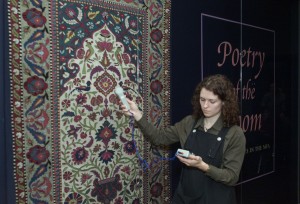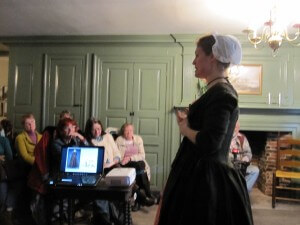I’m a Collections Manager in a large New York City institution. My first museum job was as a thirteen year old volunteer at a “living history” state park, Heritage Hill, in Green Bay, Wisconsin. Living history generally denotes that the park shares its educational mission – to educate visitors about history – via recreation of historical settings. Historical buildings or reproductions thereof are filled with animals, people fill social roles that the original occupants of the house held, and activities, such as cooking dinner, are carried out in a manner authentic to the period. Generally, a specific date is chosen, like 1836, 1871, or 1905. To perform living history well, a lot of details about the past must be collected. A living history practitioner (to use Heidi Campbell-Shoaf’s term, see her article here) must translate through their person a wealth of small material culture details, including textile history, dress, accessories, in addition to presenting mannerisms appropriate to their station.
To do this, many living history practitioners wish to perform research in collections rather than gaining this information from secondary sources. Museum staff know how to approach [most] collections, look at objects, ask for supporting material such as object files or database records, and follow up with the visited museum afterward. This isn’t so clear to others who might spend their everyday lives working as doctors, truck drivers, school teachers, and engineers. The expectation of the living history researcher might not match that of the collections manager or curator at a museum, creating misunderstandings and earning reenactors bad reputations as researchers. As a museum professional, I have often seen my colleagues, especially those in costume collections, roll their eyes when receiving research requests from living history practitioners.

Taking a light reading. Textiles are sensitive to light: keeping light levels below 50 lux for short periods of time and tracking light exposure helps museum staff preserve the textile’s appearance for future exhibition.
I inhabit both worlds: I am both a museum professional and spent a lot of my early career as a living history practitioner. Celebrating it’s fiftieth anniversary this year, the living history group the Brigade of the American Revolution holds a yearly school for its membership to share current research into material culture, the war, and how to put that knowledge into practice for public visiting our events. Research makes that happen, so I put together a lecture on performing research with museum object collections.
I included the following information in my talk:
- A short glossary of museum terms. This includes accession number (the unique number assigned to each object in a collection), provenance (the history of the object), and collections management database (the descendant of the object card catalog, the program that stores in formation about the collections).
- Who to approach to see the collection? This can be different in every institution, especially depending on the size of the institution. It can be including the Registrar, Collections Manager, Curator, Conservator, Librarian, Archivist, or even the Director in small museums.
- How to Prepare to visit. Pick a reasonable amount of objects to view in the time given. If you only have two hours, pick ten objects. Let the museum staff guide you – ask them what is reasonable. Outside visits to collections might only make up 5% of the time they spend at work. There are lots of other things going on, from exhibitions, to photography projects, storage rehousing, and construction projects. So keep in mind that their time is valuable. Define your research goals up front – don’t contact a museum and say “I want to see everything from the 18th century in your collection.” Be specific. And do your research to the greatest extent possible prior to your visit. If there is an online collections database available, try to pinpoint the types of collections you wish to see, then ask museum staff for suggestions.
- During your visit. Not all museums are the same, or have the same rules. They are charged with preservation of collections, so museum staff will call the shots about how you may work with an object. Some museum staff will let you handle collections. Others will not. This generally depends on your credentials, the fragility of the object, and how often other researchers ask to see the object. Do bring a camera, your laptop, other research you may want to compare to the object you are viewing, pencils, and a measuring tape. Do not bring your own gloves (this personally drives me crazy). It signals to the museum staff that you expect to handle the object, and puts collections staff in an awkward position if it is against museum policy.
- Looking. Collection staff spend their careers developing their skills of looking at objects, but this isn’t always a familiar skill for others. In the excitement of visiting with the object, you can forget important details, such as measurements, or how that sleeve was attached to the bodice. Start by looking at any information the staff provides. Make sure you record the accession number. First, make notes about the overall object, then progress systematically to the details. Cover the structure of the object, the material, the color, how the surface is ornamented. Take meaningful measurements and photographs. Make sure that if you are shooting details of the object that you keep a photograph log, so you aren’t scratching your head when you get home.
- Follow-up. Be a good guest and send a thank-you note. Send a summary of your research notes to the museum – they don’t always have the time or expertise that you might have, and they might incorporate your notes into the file for that object.
Educating the living history community about how to approach and work with museums not only opens the door to information that can improve living history impressions. It also assists museums to fulfill their mission of providing access by fostering a more educated researcher.


[…] a new word for the uber-serious reenactor: Living history practitioner (it’s contagious, see here). Apart from choosing the fluffy, lifeless word “practitioner,” we have to give credit […]
[…] These kinds of restrictions are part of why museums have open storage, and it’s why I wish we could have open storage. But most museums don’t, so the key to getting into the storerooms (or the research rooms) is to ask the right way. I did a presentation on the process, and there’s more good advice over at the Still Room Blog. […]
[…] An edited version of this blog first appeared at TheStillRoomBlog.com. […]